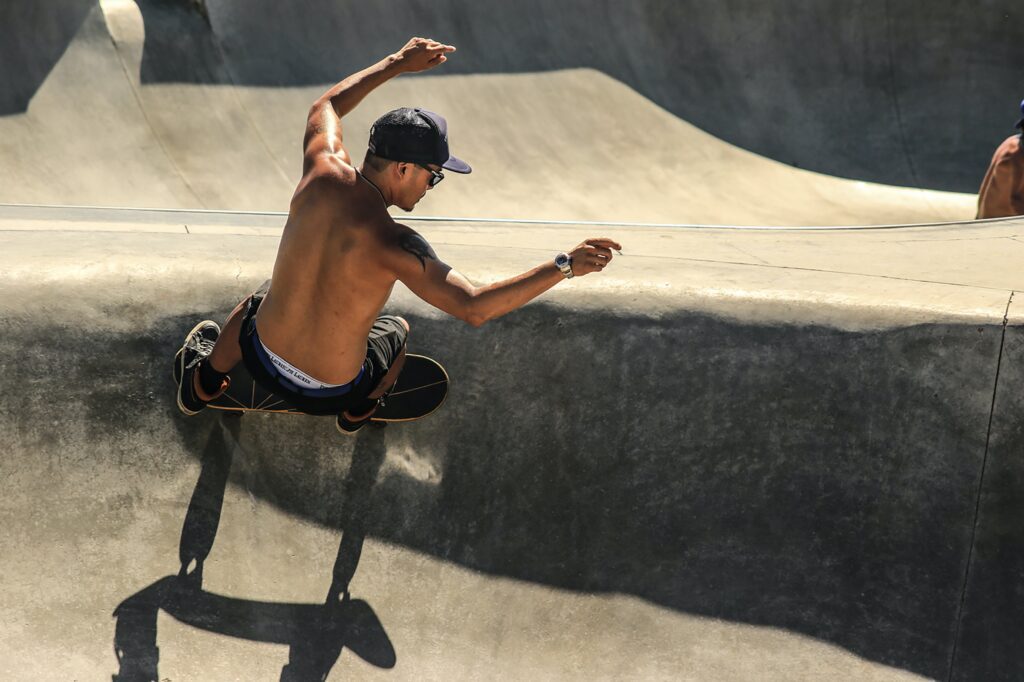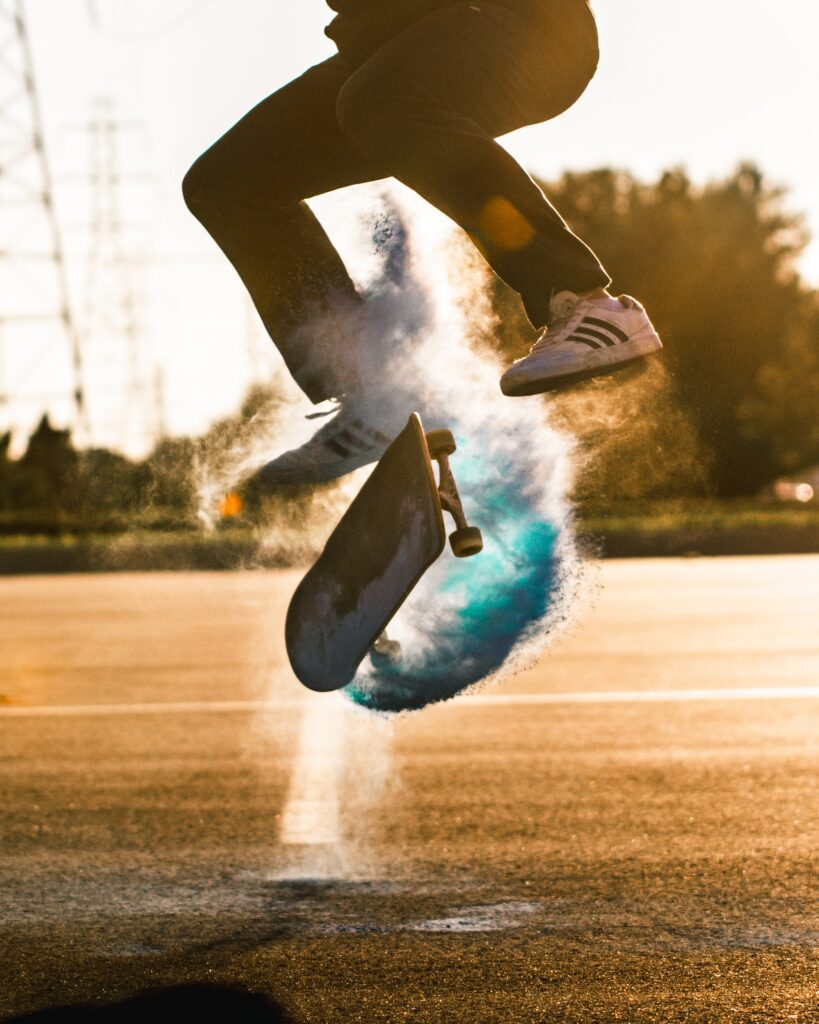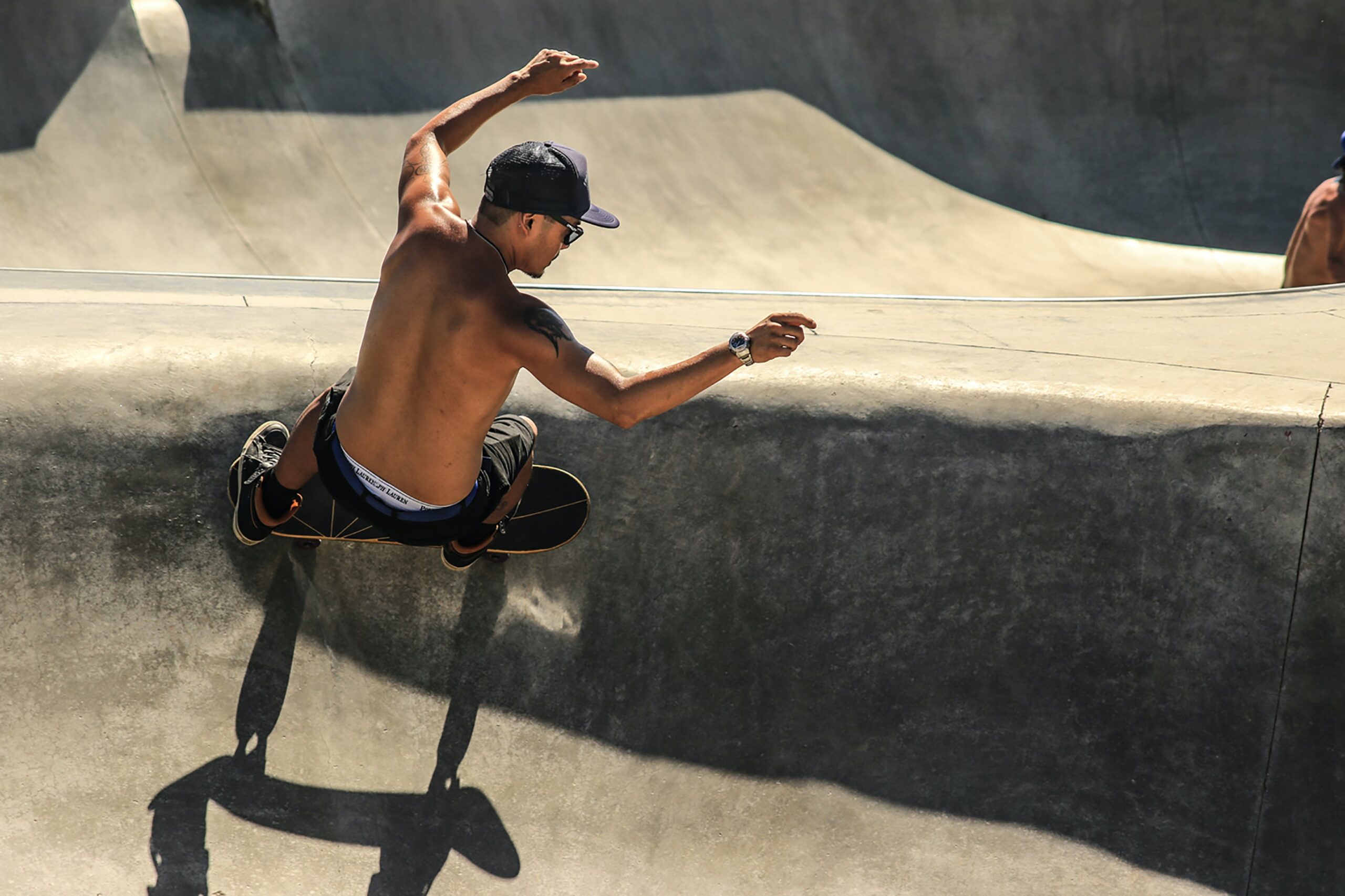Are you a beginner skateboarder eager to learn how to stop and slow down safely? Look no further! In this article, we will share some valuable tips to help you master these essential skills. Whether you’re cruising through the streets or attempting tricks at the skate park, having control over your speed is crucial for a fun and safe skateboarding experience. So grab your board, put on your protective gear, and let’s get started on this exciting journey of learning to stop and slow down on a skateboard!
1. Choosing the Right Skateboard Setup
1.1 Choosing the Right Skateboard Size
When it comes to choosing the right skateboard size, it’s essential to consider your individual preferences and riding style. The size of your skateboard can significantly impact your riding experience. A wider board provides more stability, ideal for cruising and performing tricks, while a narrower board offers more maneuverability and is perfect for street skating. Take your height, shoe size, and personal preference into account when selecting the right skateboard size.
1.2 Selecting the Right Wheels
The type of wheels you choose for your skateboard is crucial for achieving optimal performance and control. Consider the terrain you’ll be riding on and the style of skateboarding you’ll be engaging in. Softer wheels offer better grip and are suitable for cruising on rough surfaces, while harder wheels provide a smoother ride on skateparks and smoother pavements. Additionally, the durometer rating of the wheels should be taken into account. Higher durometer wheels are more durable but offer less grip, while lower durometer wheels provide better grip but are less durable.
1.3 Using the Proper Trucks
Trucks play a vital role in maintaining stability and control while skateboarding. The width of the trucks should match the width of your skateboard deck. Additionally, consider the height of the trucks as it affects the board’s response. Lower trucks provide stability and make it easier to perform tricks, while higher trucks offer more maneuverability. It’s also important to choose trucks with appropriate bushing hardness to achieve the desired responsiveness and turnability.
1.4 Ensuring the Skateboard is in Good Condition
Before hitting the streets or skatepark, it’s crucial to ensure your skateboard is in good condition. Regularly inspect the deck, trucks, wheels, and bearings for any signs of wear or damage. Replace any worn-out or damaged components to maintain optimal performance and safety. Additionally, keep your skateboard clean and properly lubricate the bearings to ensure smooth and efficient riding.
2. Understanding Basic Skateboard Stopping Techniques
2.1 Using Your Foot as a Brake
One of the simplest stopping techniques for skateboarders is using your foot as a brake. To do this, place one foot on the ground and apply gentle pressure to slow down or come to a complete stop. Remember to keep your weight centered and maintain balance while using this technique. It’s important to practice this technique in a controlled environment to build confidence and avoid accidents.
2.2 Employing the Power Slide
The power slide is an effective stopping technique that involves sliding the wheels sideways to gradually slow down or come to a stop. To perform a power slide, shift your weight slightly to the back foot, then initiate the slide by turning your shoulders and applying pressure to the tail of the skateboard. Keep your front foot slightly lifted to prevent the wheels from catching. With practice, you’ll gain more control and be able to execute the power slide smoothly.
2.3 Mastering the Foot Brake
The foot brake is a reliable stopping technique that involves dragging the sole of your back foot on the ground to create friction and slow down. To execute the foot brake, shift most of your weight onto your front foot and gradually apply pressure to the ground with your back foot. Be careful not to apply too much pressure, as it could cause the skateboard to suddenly stop. Practice this technique on smooth surfaces to develop control and avoid accidents.
2.4 Practicing the Sweeper
The sweeper technique is particularly useful for gradually slowing down instead of making abrupt stops. To perform the sweeper, position your back foot diagonally across the skateboard deck and gently swipe it back and forth on the ground. This motion creates friction, gradually decreasing your speed. Remember to maintain proper balance and posture while executing the sweeper. Practice on smooth surfaces and steadily increase your swiping motion to master this technique.

3. Developing Proper Balance and Stability
3.1 Improving Your Balance
Having good balance is essential for safely stopping and slowing down on a skateboard. Regularly practice exercises that improve your core strength, such as yoga or balance board training. Additionally, spend time simply standing on your skateboard and finding your center of balance. As you become more comfortable, try shifting your weight from side to side while stationary, gradually increasing the difficulty level.
3.2 Strengthening Your Core Muscles
Strong core muscles play a significant role in maintaining stability while skateboarding. Incorporate exercises like planks, Russian twists, and leg lifts into your workout routine to strengthen your core. A strong core will help you maintain proper posture and balance while executing stopping techniques. Remember to warm up properly before attempting any exercises, and gradually increase the intensity and duration as you progress.
3.3 Practicing on Smooth Surfaces
To develop proper balance and stability, it’s crucial to practice on smooth and level surfaces. Find a suitable area, like a parking lot or empty skatepark, where you can focus on perfecting your technique without the risk of uneven terrain tripping you up. Starting on smooth surfaces will give you the confidence and stability needed to gradually progress to more challenging terrains.
3.4 Utilizing Protective Gear
Wearing appropriate protective gear not only helps prevent injuries but also instills a sense of confidence while skateboarding. Invest in a properly fitted helmet, knee pads, elbow pads, and wrist guards to protect yourself from potential falls or accidents. Remember, safety should always be a top priority when learning new skills or improving existing ones.
4. Learning to Control Speed Through Body Movements
4.1 Distributing Your Weight
Controlling your speed on a skateboard can be achieved by distributing your weight effectively. When you want to slow down, shift more weight to your back foot, leaning slightly backward. This shift in weight transfers the momentum to the rear of the board, providing a natural braking effect. Practice distributing your weight evenly and adjusting it according to your desired speed.
4.2 Using Your Arms for Balance
Your arms can also play a crucial role in controlling speed on a skateboard. Extend your arms slightly and position them parallel to the skateboard deck. As you ride, make subtle adjustments in arm position to help maintain balance and stability. Your arms act as counterbalances, helping you control your body’s movements and speed.
4.3 Understanding Center of Gravity
Understanding your center of gravity is vital for speed control on a skateboard. Your center of gravity is the point in your body where the mass is concentrated. By keeping your center of gravity low and balanced over the skateboard, you can maintain better control and stability. Experiment with shifting your weight and keeping your body aligned to find the most effective center of gravity for speed control.
4.4 Maintaining a Low Center of Gravity
To promote stability and control at higher speeds, it’s essential to maintain a low center of gravity. Bend your knees slightly and keep your body relaxed, allowing for better absorption of any bumps or changes in terrain. By keeping a low center of gravity, you’ll have greater balance and be able to react more quickly to any speed-related challenges that may arise.

5. Techniques for Slowing Down and Stopping
5.1 Pushing Regularly to Control Speed
One of the most effective ways to control your speed on a skateboard is by pushing regularly. By consistently pushing and extending your leg, you effectively transfer some momentum into the act of pushing, slowing down your overall speed. It’s essential to practice pushing with both feet to maintain balance and evenly distribute the brake-like effect of pushing.
5.2 Performing a Controlled Foot Brake
The foot brake technique mentioned earlier can also be used as a controlled way to slow down if executed properly. Instead of making abrupt braking moves, apply gradual pressure with your back foot as you lean forward to distribute your weight evenly. This controlled foot brake technique allows you to slow down or come to a complete stop in a controlled manner, minimizing the risk of accidents.
5.3 Practicing the Power Slide for Controlled Stops
If you’re looking for a more advanced technique to control speed and execute controlled stops, the power slide is an excellent option. As mentioned earlier, the power slide involves sliding the wheels sideways to gradually slow down. By mastering this technique, you can perform stylish and controlled stops, adding flair to your skateboarding skills.
5.4 Utilizing the Sweeper to Gradually Slow Down
As mentioned before, the sweeper technique is great for gradually slowing down instead of making sudden stops. Utilize the swiping motion with your back foot and gradually increase the intensity of the motion to decrease your speed. Remember to keep your weight centered and continually adjust to maintain balance and control.
6. Mastering Foot Braking
6.1 Positioning Your Foot Correctly
To effectively execute a foot brake, position your back foot across the skateboard with the sole touching the ground. Find a comfortable and secure foot placement to maintain balance and control while applying pressure to slow down. Experiment with foot positioning until you find the position that works best for you.
6.2 Applying Pressure Gradually
When foot braking, it’s crucial to apply pressure gradually. Start with light pressure and gradually increase as needed to slow down or come to a stop. Applying too much pressure too quickly can cause the skateboard to stop suddenly and potentially throw you off balance. Practice finding the right amount of pressure needed to control your speed effectively.
6.3 Keeping Your Weight Balanced and Centered
Maintaining proper weight distribution is key to mastering foot braking. Keep your weight centered on the skateboard, with the majority of your weight on the front foot for stability. Avoid leaning too far back or forward, as this can disrupt your balance and control. Continually adjust your weight according to the speed and terrain to maintain optimal control.
6.4 Practicing on Multiple Terrains
To become proficient at foot braking, it’s important to practice on various terrains. Start on smooth surfaces to develop a good understanding of the technique, then gradually progress to rougher terrains. Practicing on different surfaces will help you adapt your braking technique and ensure your skills are versatile for any situation.

7. Perfecting the Power Slide
7.1 Finding a Suitable Practice Area
Perfecting the power slide requires a suitable practice area. Look for open spaces with smooth pavement to ensure you have enough room to execute the slide safely. Avoid busy areas or places with obstacles that could interfere with your practice.
7.2 Initiating the Slide with Your Body and Foot Placement
To initiate a power slide, position your back foot near the tail of the skateboard, creating leverage. Shift your weight slightly toward your back foot, preparing to initiate the slide. As you begin to slide, simultaneously shift your shoulders and hips in the direction you want to slide, using your body’s movements to guide the skateboard.
7.3 Controlling the Slide with Weight Distribution
The key to a controlled power slide is proper weight distribution. Keep the majority of your weight on the back foot to maintain control and slide smoothly. As you become more comfortable, experiment with adjusting your weight distribution to control the slide’s speed and length.
7.4 Progressing to More Advanced Power Slide Techniques
Once you’ve mastered the basics of the power slide, you can progress to more advanced techniques. Try incorporating 180-degree or 360-degree slides, which require more precise body and foot movements. Practice on different surfaces and experiment with various slide variations to expand your skill set.
8. Improving Speed Control with the Sweeper
8.1 Understanding the Sweeper Technique
The sweeper technique is an effective way to control speed and gradually slow down. By swiping your back foot back and forth on the ground, you create friction, which reduces your speed over time. Understanding and mastering the sweeper technique can be instrumental in maintaining control in challenging situations.
8.2 Initiating the Sweeper with Proper Foot Placement
To initiate the sweeper, position your back foot diagonally across the skateboard deck, allowing the inside edge of your shoe to make contact with the ground. This foot placement ensures maximum contact and friction between your shoe and the ground. Remember to maintain balance and keep your weight centered while swiping back and forth.
8.3 Controlling Speed with Side-to-Side Movements
To control your speed using the sweeper technique, adjust the intensity of your swiping motion. Increase the speed and range of your swipes to decrease your speed more quickly, or slow down the swiping motion to gradually reduce your speed. Practice on various surfaces to gain a better understanding of how the sweeper works on different terrains.
8.4 Gradually Increasing Sweeper Intensity
As you become more comfortable with the sweeper technique, gradually increase the intensity and speed of your swipes. This will allow you to slow down more effectively and gain better control over your speed. Remember to always be mindful of your balance and weight distribution, as these factors greatly influence the effectiveness of the sweeper technique.
9. Practicing Safe Skateboarding Techniques
9.1 Wearing Proper Protective Gear
To ensure your safety while skateboarding, always wear proper protective gear. Invest in a high-quality helmet to protect your head from potential impacts. Knee pads, elbow pads, and wrist guards are essential for protecting your joints in case of falls or accidents. Wearing the right gear significantly reduces the risk of serious injuries.
9.2 Skateboarding in Designated Areas
Skateboarding in designated areas, such as skateparks or designated skateboarding zones, not only promotes safety but also provides a controlled environment for practicing your skills. These areas are designed with the proper infrastructure and features, allowing you to skate safely without endangering yourself or others.
9.3 Being Aware of Surroundings
Maintaining awareness of your surroundings is crucial for safe skateboarding. Always be alert to potential obstacles, pedestrians, or vehicles in your vicinity. This awareness allows you to react promptly and make necessary adjustments to avoid accidents. Avoid riding with headphones or distractions that may hinder your ability to hear or see your surroundings.
9.4 Following Traffic Rules
When skateboarding on public roads or paths, it’s important to follow traffic rules. Skateboarding should be treated similarly to cycling or driving. Observe traffic signs, use hand signals to indicate your intentions, and yield to pedestrians when appropriate. Respecting traffic rules fosters a safe environment for both yourself and others sharing the space.
10. Seeking Professional Instruction and Guidance
10.1 Enrolling in Skateboarding Lessons
Enrolling in skateboarding lessons can greatly enhance your learning experience and provide valuable guidance. Professional instructors can teach you proper techniques, safety practices, and help you progress at a steady pace. Look for skateboarding schools or parks that offer lessons suitable for your skill level.
10.2 Joining Skateboarding Communities
Joining skateboarding communities or groups creates opportunities to connect with experienced skateboarders who can offer valuable tips and advice. These communities often host events, gatherings, or skate sessions where you can exchange knowledge and learn from others. Building connections within the skateboarding community can fuel your passion and accelerate your learning.
10.3 Getting Tips from Experienced Skateboarders
Establishing relationships with experienced skateboarders can provide valuable insights into advanced techniques and tips for safe learning. Reach out to local skateboarders, professional skateboarders, or use online platforms to connect with individuals who have mastered the skills you aspire to develop. Seeking advice from those who have already gone through the learning process can greatly benefit your skateboarding journey.
10.4 Attending Skateboarding Workshops and Events
Skateboarding workshops and events offer unique opportunities to learn from professionals and expand your knowledge base. These events often feature demonstrations, tutorials, and interactive sessions that cater to skaters of all levels. By attending these workshops, you can learn new techniques, receive personalized feedback, and share your passion for skateboarding with like-minded individuals.
Remember, learning to stop and slow down on a skateboard requires practice, patience, and a commitment to safety. By following these tips and putting in the effort, you’ll be well on your way to mastering the art of control and making your skateboarding experience enjoyable and safe. So grab your skateboard, gear up, and start honing your skills today!

